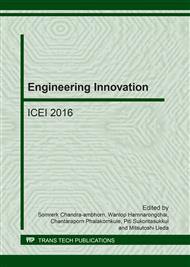p.204
p.209
p.215
p.223
p.229
p.235
p.240
p.246
p.252
Investigation of Friction and Wear Behavior of Polyoxymethylene/Poly(Lactic Acid) Blends
Abstract:
Friction and wear behavior of Polyoxymethylene/Poly (lactic acid) blends (POM/PLA) was investigated to study effect of PLA content on friction and wear properties. The sliding experiments were carried out by Frictoron EFM-III machine. POM blends sliding against the carbon steel (AISI 1045) counterpart under 200 N of pressure load, 100 mm/s of sliding speed for 60 minutes. The wear weigh loss was measured after wear experiment. Wear profile and worn surface were observed by SEM. It was found that friction coefficient of neat POM is lower than neat PLA. However, the incorporation of PLA into POM led to an increment of friction coefficient of POM blends both of 40% and 60% PLA content that over than neat POM and PLA. While wear weigh loss resulted the increasing with increasing of PLA content, which were supported by wear prolife photographs. The deformation of neat PLA and blends on worn surface originated from adhesive due to the thermal softening and melting behavior, while neat POM reveals the plough action behavior.
Info:
Periodical:
Pages:
229-234
Citation:
Online since:
January 2017
Keywords:
Price:
Сopyright:
© 2017 Trans Tech Publications Ltd. All Rights Reserved
Share:
Citation:


